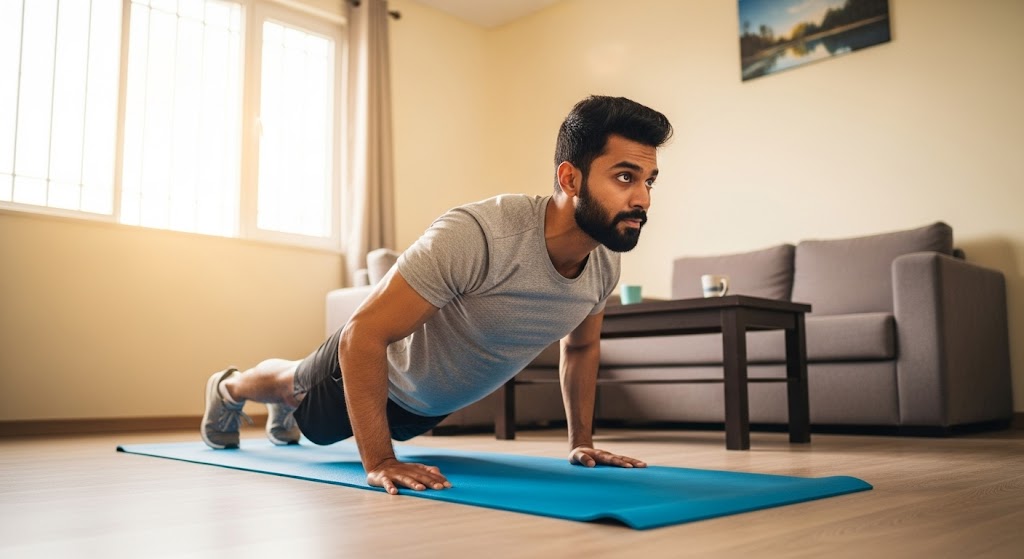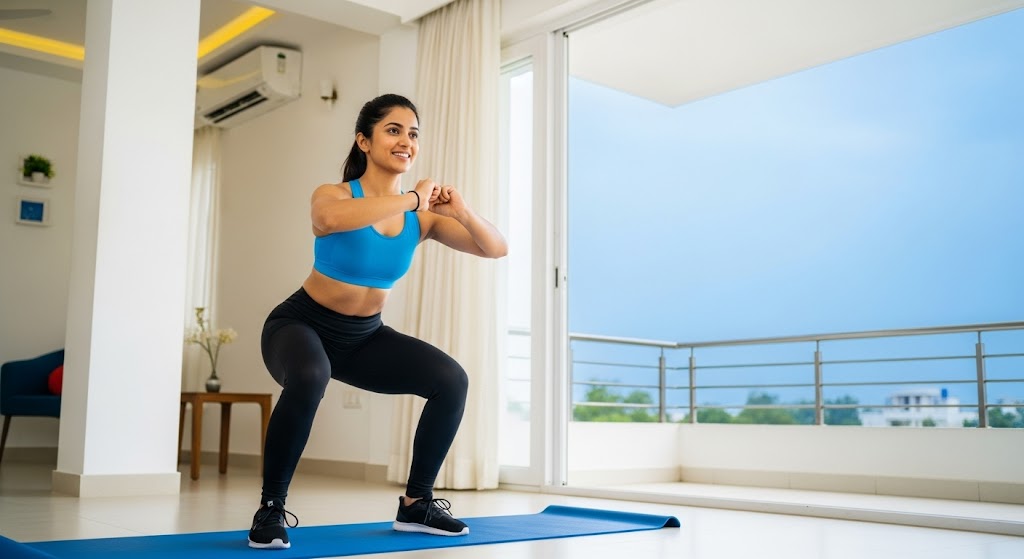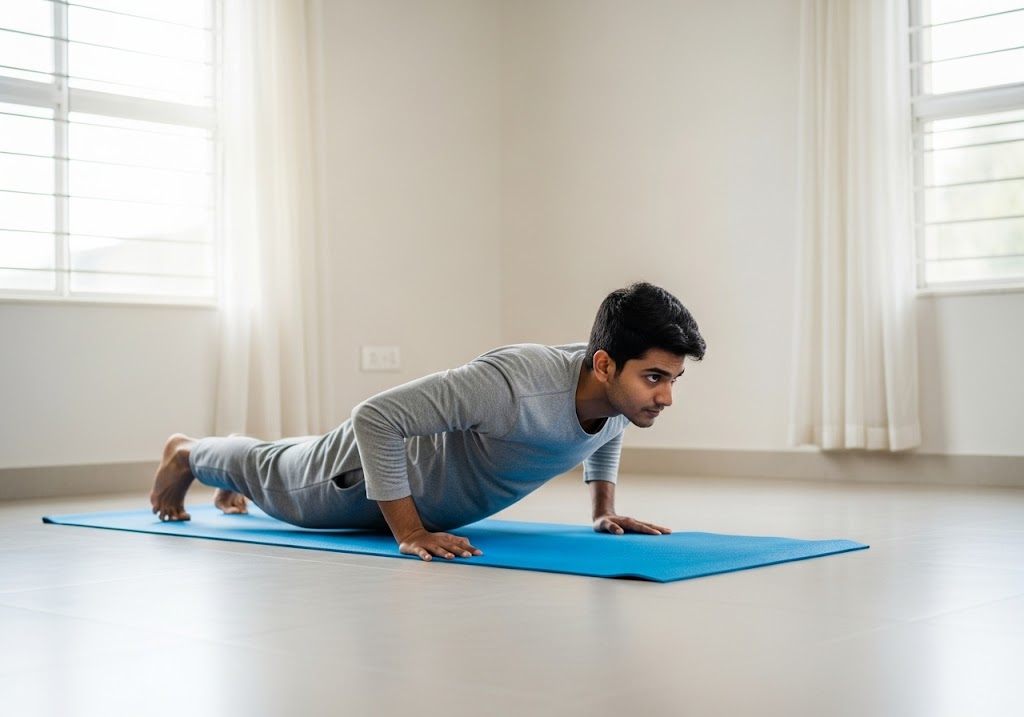The 8 steps for how to start calisthenics are: push-ups for chest, progressing from wall to decline; squats for legs, from bodyweight to pistol; planks for core, from standard to extended; pull-ups for back, from assisted to weighted; lunges for glutes, from static to reverse; dips for triceps, from assisted to weighted; burpees for full-body cardio, from modified to advanced; and bear crawls for coordination, from short to weighted.
Discovering how to start calisthenics can be overwhelming for beginners, but this bodyweight training method offers incredible benefits for people of all fitness levels. Learning how to start calisthenics doesn’t require expensive equipment or gym memberships – just your body weight and determination. This comprehensive guide will show you exactly how to start calisthenics safely and effectively, whether you’re a complete beginner or returning to fitness after a break. Understanding how to start calisthenics properly sets the foundation for a lifetime of strength, flexibility, and fitness achievement. By following this proven system, you’ll discover that knowing how to start calisthenics opens doors to incredible physical transformation and personal growth.
Table of Contents
How to Start Calisthenics Step by Step?
Learning how to start calisthenics requires a systematic approach that builds strength, mobility, and confidence progressively. This step-by-step method ensures you develop proper form while avoiding common beginner mistakes. Follow these proven steps to begin your calisthenics journey safely and effectively.
| Step | Focus Area | Duration | Difficulty |
| 1 | Fitness Assessment | 30 minutes | Beginner |
| 2 | Basic Mobility Work | 2-3 weeks | Beginner |
| 3 | Foundation Exercises | 4-6 weeks | Beginner |
| 4 | Form Perfection | 2-4 weeks | Beginner |
| 5 | Routine Development | 1-2 weeks | Beginner |
| 6 | Progressive Overload | Ongoing | Intermediate |
| 7 | Skill Development | 3-6 months | Intermediate |
| 8 | Advanced Movements | 6+ months | Advanced |

Step 1: Fitness Assessment Begin your journey of how to start calisthenics by honestly assessing your current fitness level. Test basic movements like push-ups, squats, and planks to understand your starting point. This assessment helps you choose appropriate exercises and prevents injury during your initial training phase.
Step 2: Basic Mobility Work Develop the flexibility and mobility necessary for safe calisthenics practice. Focus on shoulder, hip, and ankle mobility through daily stretching routines. This foundation work is crucial for learning how to start calisthenics without limitation or injury risk from tight muscles and joints.
Step 3: Foundation Exercises Master fundamental movements that form the basis of all calisthenics training. Practice push-ups, squats, planks, and basic pulling movements with perfect form. These exercises teach you how to start calisthenics with proper movement patterns and body awareness essential for advancement.
Step 4: Form Perfection Dedicate time to perfecting your form in basic exercises before progressing to advanced movements. Focus on quality over quantity, ensuring each repetition is performed with control and precision. This attention to detail is fundamental to how to start calisthenics training safely and effectively.
Step 5: Routine Development Create a structured workout routine that fits your schedule and goals. Plan training sessions that balance different movement patterns and allow adequate recovery time. This systematic approach ensures you understand how to start calisthenics workout planning for consistent progress and results.
Step 6: Progressive Overload Gradually increase the difficulty of your exercises to continue building strength and skill. This might involve adding repetitions, changing exercise variations, or extending hold times. Progressive overload is essential for understanding how to start calisthenics training that produces continuous improvement and growth.
Step 7: Skill Development Begin working on intermediate skills like handstands, muscle-ups, and advanced pushing movements. These skills require patience and consistent practice to master. This phase teaches you how to start calisthenics skill development while maintaining your foundation strength and mobility.
Step 8: Advanced Movements Progress to challenging movements that require significant strength, balance, and coordination. These advanced skills represent the culmination of dedicated calisthenics training. This final step shows how to start calisthenics progression toward mastery and elite-level performance in bodyweight training.

What is Calisthenics?
Calisthenics is a form of physical training that uses your body weight as resistance to build strength, flexibility, and endurance. When people ask how to start calisthenics, they’re exploring one of the most accessible and effective forms of exercise available. This training method emphasizes natural movement patterns and functional strength development through exercises like push-ups, pull-ups, squats, and planks.
The beauty of calisthenics lies in its simplicity and scalability. Understanding how to start calisthenics means recognizing that this training method requires no equipment while offering endless progression possibilities. From basic movements to advanced skills like handstands and muscle-ups, calisthenics provides a complete fitness system that grows with your abilities and keeps you challenged throughout your fitness journey.
How to Start Calisthenics for Beginners?
Starting your calisthenics journey as a beginner requires understanding fundamental principles and realistic expectations. This systematic approach ensures you build strength safely while developing the skills necessary for long-term success in bodyweight training.
| Beginner Requirement | Minimum Standard | Development Time |
| Basic Mobility | Touch toes, overhead reach | 2-4 weeks |
| Push-up Strength | 5-10 modified push-ups | 4-8 weeks |
| Pulling Ability | Assisted pull-ups | 6-12 weeks |
| Core Strength | 30-second plank | 2-6 weeks |
| Leg Strength | 15-20 bodyweight squats | 2-4 weeks |
| Balance | Single-leg stands | 1-2 weeks |

How to Start Calisthenics at Home?
Learning how to start calisthenics at home offers convenience and privacy while providing all the benefits of this incredible training method. Home training eliminates barriers like gym costs and travel time, making it easier to maintain consistency in your fitness routine.
- Space Requirements: Clear 6×6 feet area for safe movement and exercise performance
- Wall Access: Vertical wall space for handstand practice and modified exercises
- Floor Surface: Non-slip surface or exercise mat for stability and joint protection
- Ceiling Height: Adequate clearance for jumping and overhead movements
- Ventilation: Good airflow to maintain comfort during intense training sessions
- Minimal Distractions: Quiet environment that allows focus on form and technique
How to Get Started with Calisthenics Equipment?
While learning how to get started with calisthenics requires minimal equipment, certain tools can enhance your training experience and accelerate progress. Understanding equipment options helps you make informed decisions about worthwhile investments for your training setup.
- Pull-up Bar: Essential for developing upper body pulling strength and back muscles
- Resistance Bands: Excellent for assistance work and adding resistance to exercises
- Exercise Mat: Provides cushioning and grip for floor exercises and stretching
- Parallettes: Useful for wrist comfort and advanced skills like L-sits
- Gymnastics Rings: Advanced equipment for upper body strength and skill development
- Timer/App: Helps track workout duration and rest periods for structured training

Basic Calisthenics Exercises to Start With
Understanding how to start calisthenics workout begins with mastering fundamental exercises that build total-body strength and movement competency. These basic movements form the foundation for all advanced calisthenics skills and provide comprehensive fitness benefits.
| Exercise | Primary Muscles | Difficulty | Progressions |
| Push-ups | Chest, shoulders, triceps | Beginner | Wall → Knee → Full → Decline |
| Squats | Legs, glutes, core | Beginner | Bodyweight → Jump → Pistol |
| Planks | Core, shoulders | Beginner | Standard → Side → Extended |
| Pull-ups | Back, biceps | Intermediate | Assisted → Full → Weighted |
| Lunges | Legs, glutes, balance | Beginner | Static → Walking → Reverse |
| Dips | Chest, triceps, shoulders | Intermediate | Assisted → Full → Weighted |
| Burpees | Full body, cardio | Intermediate | Modified → Full → Advanced |
| Bear Crawls | Full body, coordination | Beginner | Short → Long → Weighted |
How to Start Calisthenics Workout Routine?
Creating your first routine is crucial for understanding how to start calisthenics workout effectively. A well-structured routine balances different movement patterns while allowing adequate recovery time for strength development and skill acquisition.
| Workout Component | Duration | Frequency | Purpose |
| Warm-up | 5-10 minutes | Every session | Injury prevention |
| Strength Training | 20-30 minutes | 3-4x per week | Muscle development |
| Skill Practice | 10-15 minutes | 3-4x per week | Movement quality |
| Cool-down | 5-10 minutes | Every session | Recovery promotion |
| Rest Days | Full day | 3-4x per week | Adaptation and growth |
| Progress Review | 15 minutes | Weekly | Program adjustment |

How to Start Calisthenics Training Progression
Understanding how to start calisthenics training progression ensures continuous improvement and prevents plateaus. This systematic approach to advancement keeps your training challenging while maintaining safety and proper form development.
| Progression Method | Application | Timeline | Example |
| Repetition Increase | Add 1-2 reps weekly | 2-4 weeks | 8 push-ups → 15 push-ups |
| Set Addition | Add extra sets | 3-6 weeks | 2 sets → 4 sets |
| Exercise Variation | Change difficulty | 4-8 weeks | Push-ups → Decline push-ups |
| Tempo Manipulation | Slow/controlled movement | 2-4 weeks | 2-second holds |
| Range of Motion | Increase movement depth | 3-6 weeks | Partial → Full squats |
| Skill Development | Learn new movements | 3-12 months | Basic → Handstand |
Common Mistakes When Starting Calisthenics
Learning how to start calisthenics involves avoiding common pitfalls that can slow progress or lead to injury. Understanding these mistakes helps you train more effectively while maintaining safety throughout your fitness journey.
- Rushing Through Progressions: Attempting advanced movements before mastering basics leads to poor form and potential injury
- Neglecting Warm-up: Skipping preparation increases injury risk and reduces training effectiveness significantly
- Ignoring Form Quality: Focusing on quantity over quality prevents proper strength development and skill acquisition
- Inconsistent Training: Sporadic workouts prevent the adaptations necessary for strength and skill development
- Overtraining: Training too frequently without adequate recovery leads to burnout and injury
- Setting Unrealistic Goals: Expecting rapid progress creates frustration and often leads to quitting
- Comparing to Others: Focusing on others’ progress rather than personal improvement damages motivation
- Neglecting Nutrition: Poor eating habits limit recovery and progress in calisthenics training
Creating Your First Workout Plan
Planning your initial training routine is essential for understanding how to start calisthenics training systematically. A well-designed plan ensures balanced development while preventing overtraining and maintaining motivation through structured progression.
- Training Frequency: Start with 3 sessions per week, allowing rest days for recovery
- Session Duration: Begin with 30-45 minute sessions including warm-up and cool-down
- Exercise Selection: Choose 4-6 basic movements covering all major muscle groups
- Set and Rep Scheme: Perform 2-3 sets of 8-12 repetitions for most exercises
- Progression Planning: Increase difficulty gradually based on strength improvements
- Recovery Emphasis: Schedule rest days and prioritize sleep for optimal adaptation
Advanced Calisthenics Considerations
Once you’ve mastered the basics of how to start calisthenics, advanced considerations become important for continued progress. These factors help you transition from beginner to intermediate practitioner while maintaining safety and effectiveness.
Advanced practitioners often explore specialized areas like calisthenics planche training or back calisthenics exercises for targeted development. Understanding these advanced concepts helps you plan your long-term calisthenics journey.
Many people wonder does calisthenics build muscle effectively. The answer is yes, and starting with proper fundamentals ensures you maximize muscle building potential throughout your training journey.
Nutrition and Recovery for Beginners
Supporting your calisthenics training with proper nutrition and recovery practices accelerates progress and prevents injury. Understanding these fundamentals is crucial for anyone learning how to start calisthenics training effectively.
Proper nutrition provides the energy and nutrients necessary for strength development and recovery. Focus on whole foods, adequate protein intake, and proper hydration to support your training efforts. Recovery practices like adequate sleep and stress management are equally important for optimal progress.
The combination of training with proper nutrition creates an ideal environment for fitness success. This approach makes calisthenics accessible to everyone regardless of budget or location.
Building Long-term Success
Understanding how to start calisthenics is just the beginning of a lifelong fitness journey. Building long-term success requires patience, consistency, and a growth mindset that embraces challenges and celebrates progress.
Consider exploring different aspects of calisthenics training such as calisthenics pull workout routines or understanding calisthenics vs gymnastics differences to broaden your knowledge and skills.
The journey of how to start calisthenics training evolves as you develop strength, skills, and confidence. Embrace this evolution and enjoy the process of continuous improvement and personal growth.
Conclusion
Learning how to start calisthenics is an incredible journey that transforms both body and mind through systematic bodyweight training. This accessible fitness method requires no equipment or gym membership, making it perfect for anyone regardless of budget or location. With proper progression, consistency, and patience, anyone can master fundamental movements and advance to impressive skills. The key lies in following proven methods, maintaining realistic expectations, and celebrating victories. Start your journey today.
Want to master the calisthenics handstand and take your skills to the next level? Whether you’re a beginner or pushing advanced skills, ISC – Indian School of Calisthenics offers expert guidance to help you master bodyweight training. Visit us at SRPF Ground, NH8, Goregaon (E), Mumbai – 400065. For class schedules, personalized coaching, or more details, call +91 77159 53218. Train smart, move better, and unlock your back strength with ISC.
How to Start Calisthenics? – FAQs
How do I start calisthenics as a complete beginner?
Begin with basic movements like push-ups, squats, and planks. Focus on proper form, start with 3 sessions weekly, and progress gradually as strength improves.
What equipment do I need to start calisthenics?
You need minimal equipment – just your body weight. Optional items include pull-up bar, exercise mat, and resistance bands for enhanced training.
How long does it take to see results from calisthenics?
Most beginners see strength improvements within 2-4 weeks and visible changes within 6-8 weeks of consistent training and proper nutrition.
Can I start calisthenics at home without a gym?
Absolutely! Calisthenics is perfect for home training. You need minimal space and no equipment to begin your bodyweight training journey.
What are the best beginner calisthenics exercises?
Start with push-ups, squats, planks, lunges, and assisted pull-ups. These exercises build foundation strength for all advanced movements.
How often should beginners train calisthenics?
Begin with 3 sessions per week, allowing rest days for recovery. Consistency is more important than frequency for beginners.
Is calisthenics good for weight loss?
Yes, calisthenics burns calories while building muscle, boosting metabolism and promoting fat loss when combined with proper nutrition.
What should I eat when starting calisthenics?
Focus on whole foods with adequate protein (1.6-2.2g per kg body weight), complex carbohydrates, and proper hydration for optimal recovery.
How do I progress in calisthenics training?
Progress by increasing repetitions, adding sets, trying harder variations, or learning new skills. Advance gradually while maintaining proper form.
Can older adults start calisthenics safely?
Yes, calisthenics is excellent for older adults. Start slowly, focus on mobility and basic movements, and consult healthcare providers when needed.


